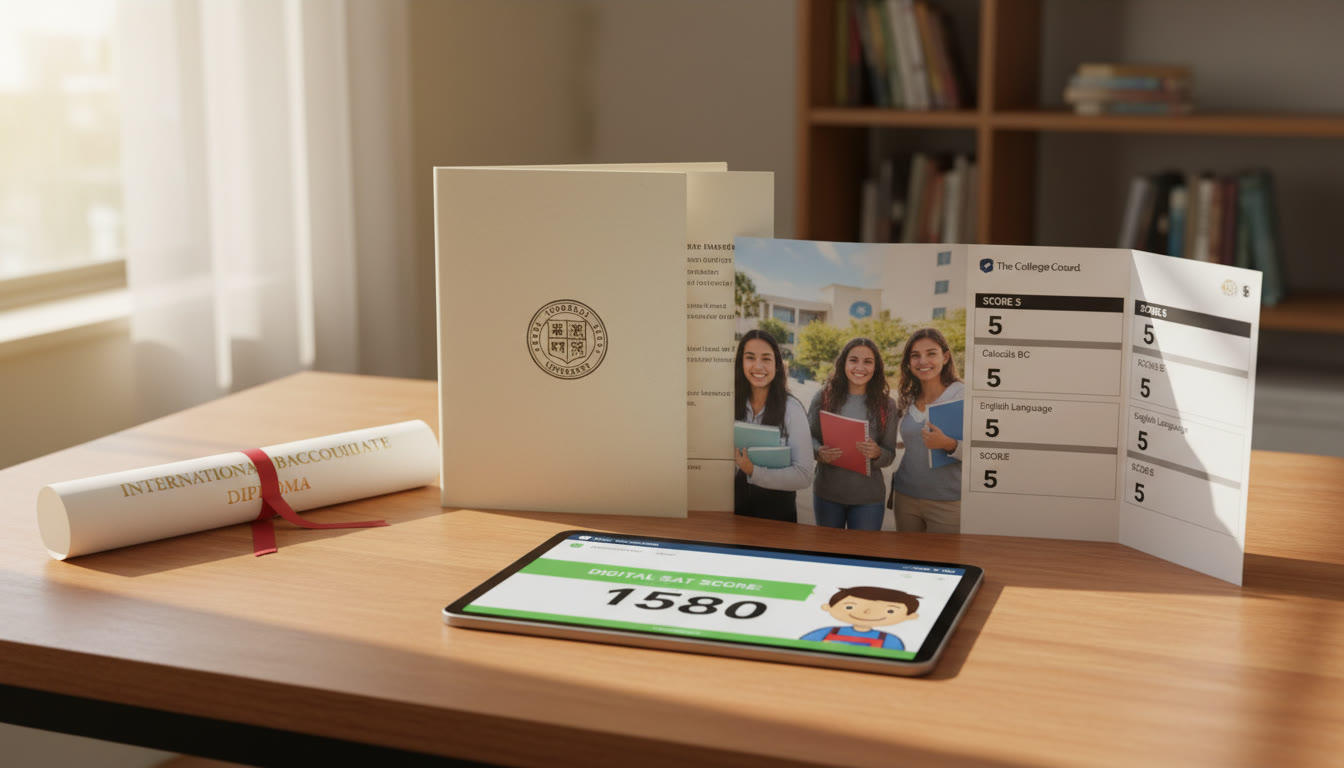AP vs SAT: A Welcome Conversation for IB Students
If you’re an International Baccalaureate (IB) student or a parent of one you probably juggle a full roster of essays, internal assessments, and a schedule that sometimes feels like a small university. Add to that the question: should I also take AP courses or the Digital SAT? Or both?
This isn t just an academic debate. It s a practical decision about how to spend a limited resource your time while maximizing college opportunities, admissions advantages, and even potential college credit. In this blog I ll walk you through the differences, the overlaps, the strategic benefits, and realistic scenarios tailored for IB students so you can make a calm, confident choice.

Why IB Students Ask This Question
IB students are uniquely positioned: rigorous coursework, extended essays, internal assessments, and a diploma that already signals academic ambition. That background changes the calculus when considering AP classes and the SAT. You might ask:
- Will AP exams add meaningful value to my college application beyond the IB?
- Do colleges prefer SAT scores even if I have a strong IB transcript?
- Is it realistic to prepare for AP exams and the Digital SAT without burning out?
All great questions. Let s unpack them step by step.
At Their Cores: What AP and the Digital SAT Test
AP (Advanced Placement)
AP courses are college-level classes offered in high school across a wide range of subjects history, biology, calculus, literature, computer science, and more. Each course typically culminates in an AP Exam administered in May. High scores (usually 3 5 depending on the college) can earn you college credit or advanced placement, meaning you could skip introductory college courses.
Digital SAT
The Digital SAT assesses evidence-based reading and writing and math, delivered on a digital device. It s used by many colleges in the admissions process as a standardized snapshot of college readiness. The test is shorter than the old paper test, uses adaptive sections, and focuses on problem-solving, analysis, and concise written expression.
Big Picture Differences That Matter to IB Students
- Depth vs Breadth: AP exams measure mastery in a specific subject at college-level depth. The SAT measures general reasoning and readiness across verbal and quantitative domains.
- Timing and Frequency: AP Exams are taken in May (once a year) and reflect a year (or more) of coursework. The Digital SAT is offered multiple times a year and can be retaken more easily.
- College Credit vs Admissions Signal: AP scores can directly translate to college credit or placement. SAT scores are primarily an admissions metric (though strong scores can influence merit scholarships and admissions decisions).
- Workload Integration: AP prep is often built into your class time (if your school offers the course). SAT prep is largely an out-of-class focused test prep activity though practice can be woven into school study time.
Common IB Student Scenarios: Which Path Fits?
IB students aren t a single category your workload, college goals, target schools, and personal resilience all vary. Here are realistic scenarios and recommended approaches.
Scenario 1: You re applying to competitive universities and want maximum flexibility
Do both, selectively. Take APs in subjects that align with your intended major or where the AP complements IB Higher Level (HL) subjects. Meanwhile, aim for a strong Digital SAT score early enough to allow a retake if needed. Admissions teams like to see rigor (IB HL) plus demonstrated mastery (AP scores) and solid standardized testing.
Scenario 2: You want to focus on the IB Diploma and avoid overload
Choose quality over quantity. Skip additional AP coursework unless it s a clear strategic fit perhaps an AP that overlaps with your IB SL/HL content and requires minimal extra time. Prioritize one well-planned SAT test date in a lighter term, and choose targeted SAT prep resources. Many students succeed by taking the SAT once or twice with focused practice.
Scenario 3: You re aiming to earn college credit to save tuition/time
AP Exams can directly lead to credit at many institutions check universities credit policies. Pair APs in subjects where you ve already covered similar material through IB (for instance, AP Calculus alongside IB Math HL if the syllabi align). Use the Digital SAT to keep admissions options open without overinvesting in retakes.
Scenario 4: You want to strengthen your application because of a lower GPA or fewer extracurriculars
A strong SAT score can bolster your profile as an objective academic signal. AP exam success also helps. Choose the path that plugs the most obvious gap for admissions committees, excellent test scores or standout AP results both provide concrete evidence of academic ability.
How Colleges View AP, IB, and the SAT Together
Admissions officers see each element differently but generally as complementary puzzle pieces. IB indicates sustained academic rigor, AP shows specific subject mastery, and the SAT offers a standardized comparison across applicants. For competitive programs, the combination of IB HL courses plus strong AP scores and a solid SAT can be compelling.
Practical tip:
If your school already offers strong IB instruction, prioritize AP exams that align with your IB subjects and where you can realistically achieve a high score. A single 5 on an AP exam in a relevant subject can sometimes have more impact than multiple 3s across unrelated APs.
Time Management: Real Weekly Schedules
One of the biggest concerns is how to fit AP prep and SAT practice into an already packed IB schedule. Here are two sample weekly plans one for a busy HL term and one for a lighter semester.
| Week Type | IB Coursework | AP Prep | SAT Practice |
|---|---|---|---|
| High Load (HL Exams + IA deadlines) | 10 15 hrs (class, lab, IA work) | 1 2 hrs (targeted review, past free-response questions) | 2 hrs (timed section practice twice weekly) |
| Lighter Load (Early Year or Break) | 6 8 hrs | 3 4 hrs (deeper content review, practice exams) | 3 4 hrs (full-length digital practice tests and review) |
Note: These are averages your ideal balance may differ. The key is consistent, focused practice rather than sporadic long sessions.
Study Strategies That Work for Both AP and the Digital SAT
- Smart, Short Daily Habits: Fifteen to thirty focused minutes daily often beats irregular marathon sessions. For AP, do topic questions or past free-response prompts; for the SAT, do timed passages or problem sets.
- Mastery, Not Memorization: Both exams reward deep understanding. For AP, that means synthesizing concepts and practicing written explanations. For the SAT, that means reasoned approaches to unfamiliar problems.
- Practice Under Real Conditions: For AP, practice full-length free-response sections with time limits. For the Digital SAT, use official digital practice platforms to simulate adaptive timing and keyboard tools.
- Data-Led Review: Track your error patterns weak grammar rules, algebraic manipulations, or question types and target those. Personalized tutoring can fast-track this process.
How Personalized Tutoring Helps (Yes Including Sparkl s Approach)
Personalized tutoring can be a game-changer when balancing IB, AP, and SAT prep. A tailored tutor will:
- Diagnose your precise strengths and gaps quickly.
- Design a study plan that syncs with IB deadlines and reduces overlap.
- Offer targeted techniques how to write concise AP free-response answers or time the Digital SAT s adaptive sections.
Sparkl s personalized tutoring model one-on-one guidance, tailored study plans, expert tutors, and AI-driven insights can be particularly helpful for IB students who need adaptive pacing and feedback that respects their IB workload. The benefit isn t just higher scores; it s less stress, smarter time use, and clearer decisions about where to invest effort.
AP vs SAT: Cost, Accessibility, and Practicalities
- Cost: AP exams carry a per-exam fee; the Digital SAT has a registration fee. Fee waivers or assistance may exist check with your school or testing authority.
- Accessibility: AP courses require your school to offer them (or you to arrange independent exam registration). The Digital SAT is available at designated test dates and locations and now commonly administered on school-approved devices or via approved testing centers.
- Retake Policies: AP Exams are taken once per academic year so timing matters. The Digital SAT is offered multiple times a year, giving you flexibility to retake if needed.
Sample Decision Flowchart: A Simple Way to Decide
Answer these quick questions to find a starting point:
- Are you applying to colleges that give credit for AP scores? Yes Consider APs aligned with your major. No Prioritize admissions signal (SAT) and IB performance.
- Do you already have a heavy IB load this year? Yes Limit extra APs and pick one SAT date during a lighter term. No Consider adding 1 2 APs strategically and plan SAT prep in cycles.
- Do you need objective proof of readiness (e.g., to offset a weaker GPA)? Yes Invest in SAT prep and 1 2 APs. No Focus on IB HL coursework and well-targeted APs.
How to Plan a 12-Month Timeline (Practical Example)
Here s a sample timeline for a junior or senior IB student who wants to balance both AP and SAT without burning out.
- Months 1 3: Diagnostic phase. Take an official practice digital SAT and a timed AP free-response practice in the subjects you re considering. Identify weak areas. If possible, work with a tutor to create a plan.
- Months 4 6: Skill-building phase. Deepen AP content understanding and build SAT test-taking strategies. Do short daily practice and weekly timed sections for SAT. For AP, do weekly timed FRQs and review rubrics.
- Months 7 9: Application phase. If taking AP exams in May, begin intensive review and full-length practice for both AP and SAT. Consider one SAT attempt in a lighter month.
- Months 10 12: Refinement phase. Review mistakes, take a final SAT attempt if needed, and finalize AP exam readiness. Use tutoring sessions for targeted feedback and polishing responses.
What Admissions Officers Notice Most
Beyond scores, admissions officers look at coherence and evidence of intellectual curiosity. An IB student who takes an AP to deepen knowledge in a field related to their intended major tells a clear story: you pursued depth purposefully. Conversely, a strong SAT score paired with a rigorous IB transcript offers a clean, measurable portrait of readiness. Either path is valid; the key is to build a consistent narrative.

Common Myths Debunked
- Myth: Colleges prefer AP over IB. Reality: Colleges value rigor and context; a strong IB diploma is highly respected. APs add subject-specific evidence, not categorical superiority.
- Myth: You must take both APs and the SAT to get into top schools. Reality: Many admitted students present a range of test and coursework combinations quality matters more than quantity.
- Myth: High SAT score eliminates need for APs. Reality: SATs are an admissions snapshot; APs can earn college credit and demonstrate depth in a subject.
Concrete Next Steps for Students and Parents
If you re wondering where to start, try this practical three-step plan:
- Take a diagnostic: one official digital SAT practice test and one past AP free-response in a subject you might take. This helps you know how much work is needed.
- Map your calendar: mark IB internal assessment deadlines, mock exams, the May AP exam window, and preferred SAT dates. Choose one or two realistic target test dates for the SAT and one or two AP exams to prioritize.
- Build support: consider targeted tutoring. A tutor who understands both AP rubrics and the Digital SAT s structure can tailor a study plan that preserves your IB performance while maximizing test outcomes. Personalized programs like Sparkl s 1-on-1 guidance, tailored study plans, expert tutors, and AI-driven insights help you stay efficient and focused.
Final Thoughts: Double Up, Choose One, or Mix and Match?
There s no single right answer, only the right answer for you. IB students have an advantage demonstrable rigor and transferable skills. APs are powerful when they align with your interests and college goals; the Digital SAT is a valuable, objective signal that can open doors or strengthen applications. For many IB students, a mix selective APs plus a well-timed SAT attempt hits the sweet spot.
Ultimately, think in stories: what story do you want your transcript, scores, and essays to tell? If your narrative is coherent demonstrating curiosity, skill, and thoughtful direction admissions officers will follow it. And along the way, smart support through personalized tutoring can keep you sane and successful: higher scores, less wasted effort, and a clearer path to the colleges you want.
Parting encouragement
You don t need to be perfect at everything. You need to be strategic, honest about where you can improve, and intentional about where to invest your energy. Whether you double up or choose one path, do it with a plan and with someone who can help you iterate that plan as exams and deadlines approach.
Good luck and remember: depth, clarity, and steady practice often beat last-minute intensity. You ve already chosen a rigorous path as an IB student. Now choose the AP and SAT strategy that makes that path clearer, not heavier.

















No Comments
Leave a comment Cancel